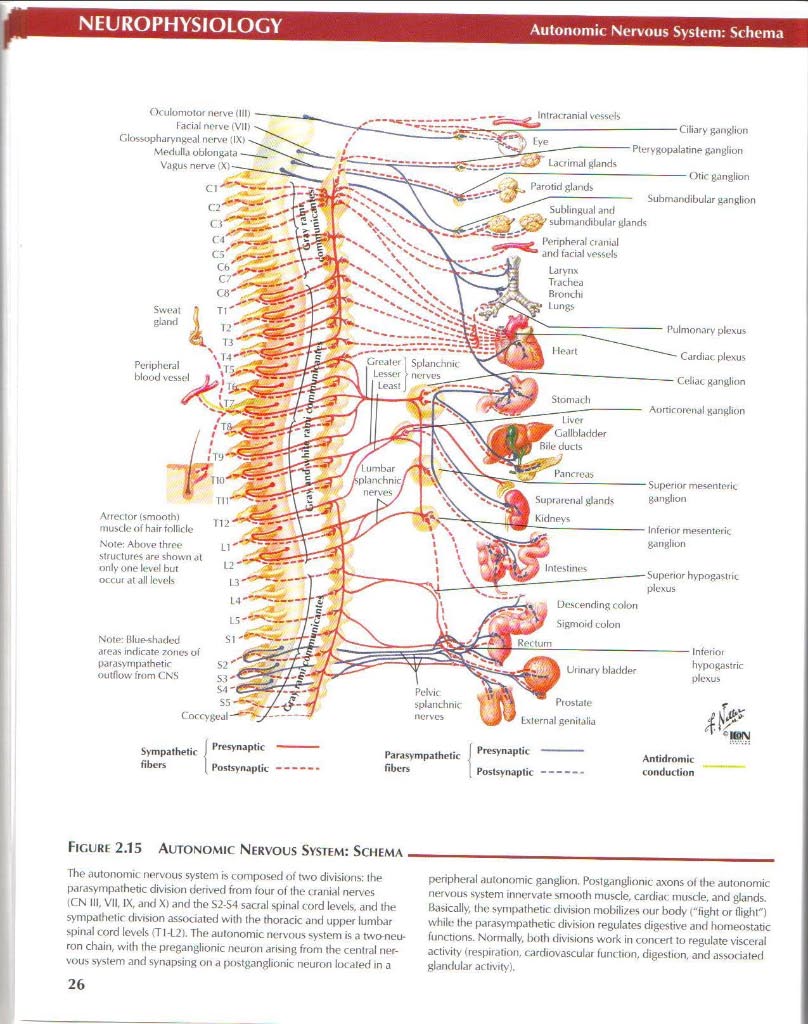netter16

NEUROPHYSIOLOGY
Autonomie Nervous System: Schema
Intracranial wssels
Facial nenie (VII > haryngeal nerve !IX> ^ vtedulla oblongata •— Vagu$ nerve (X)-~
Lacrimal glands
Parotid glands
„—^ Subłmgual and iy submandibular glands
Peripheral cranial ' and facial ve$$ds laiynx Trathea Rronclii Lungs
zones of
Grcaler I Splanchnic
Lesser > ncrvc*s___
Leas; I
Lumbar olane hmei nerves J
Heart
Stornach
^Callbladder Bile ducls
Pancrcas
Supraicnal glands
Kidneys
Intestines
Deśr.ending colon Sigmoid colon
Rectum
Unnji v bładder
PcKric. Jj splanchnic
Prostatę txlernal genitalia
Figurę 2.15 Autonomic Nervous System: Schema .
The autonomie nervous system is composed of two divisions: Ihe parasympathetic division denved from four of ihe cranial nerves 1CN III, VII, IX, and X) and the S2-54 sacral spinał cord levels, and ihe sympathelir rihision associated with the thoracic and upper lumbar spinał cord level$ (TI-L2K The autonomic nefvous system is a two-neu* ron chain, with the preganglionic neuron arising from the central ner-vous system and synapsing on a f mstganglionic neuron located in a
peripheral autonomic ganglion. Poslgangliomc axons ol tlie autonomic nervous system innervate smooth musde, cardiac muscle, and glands. Basically, the sympathetic division mobili/es our body ("fight or flight") while Ute parasympathetic divtsion regulates digestive and homeostatic ftinctions. Normally. bóth divisions work in concert to regulate visceral activity (respiration, cardiovascular function, digestion. and associaled glandular actrvity).
26
Wyszukiwarka
Podobne podstrony:
netter36 NEUROPHYSIOLOGY Audilory System: Pathways temporal lobe cortex Medial geniculate body High
netter40 NEUROPHYSIOLOGYGustatory (Taste) System: Pathways Sensory cortex łjust below face area) Lat
netter125 fntpric Nervous SystemGASTROINTESTINAL PHYSIOLOGY WW Myenteric plexus (cross section; bema
56281 netter15 Peripheral Nervous SystemNEUROPHYSIOLOGY Postorior horn Dotsal root ganglion Sensory
netter17 NEUROPHYSIOLOGYAutonomie Ncrvous System: Cholinergic and Adrenergic Synapses
24728 netter125 fntpric Nervous SystemGASTROINTESTINAL PHYSIOLOGY WW Myenteric plexus (cross section
netter125 fntpric Nervous SystemGASTROINTESTINAL PHYSIOLOGY WW Myenteric plexus (cross section; bema
netter39 Custatory (Taste) System: Receptors NEUROPHYSIOLOGY A. Tongue B. Section
netter38 NEUROPHYSIOLOGYVcstibular System: Vestihulospin.il Tracts Figurę 2.37 Vestibulospinal Tract
więcej podobnych podstron